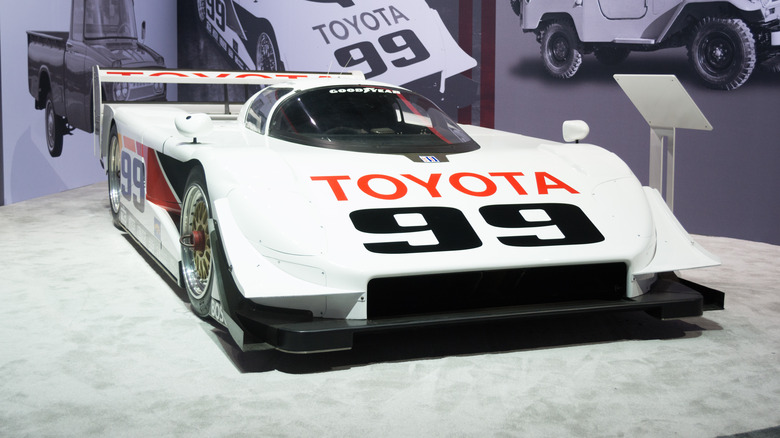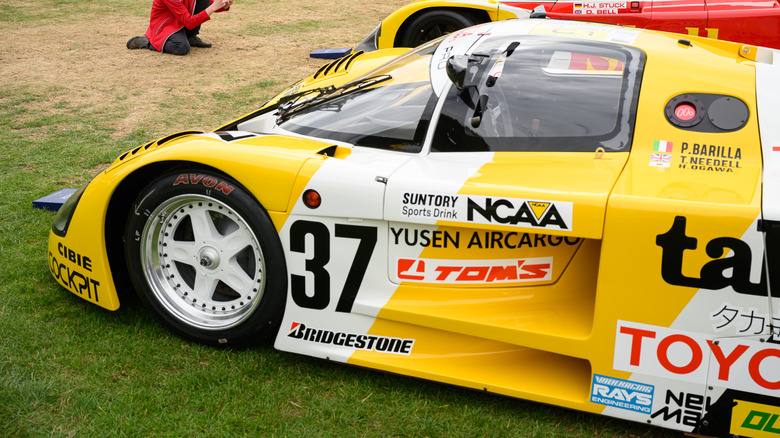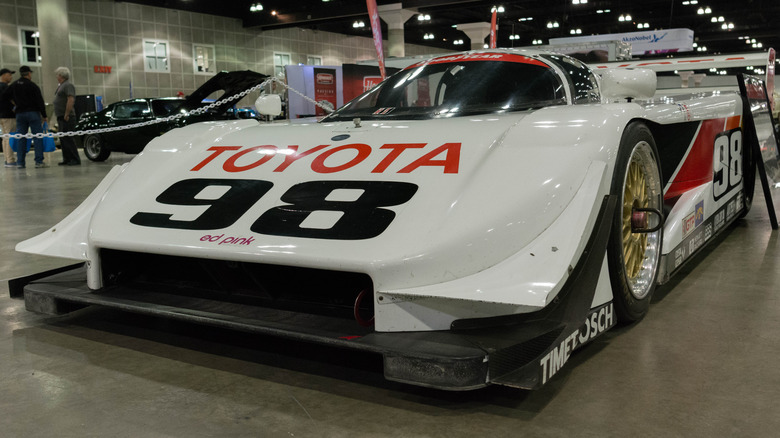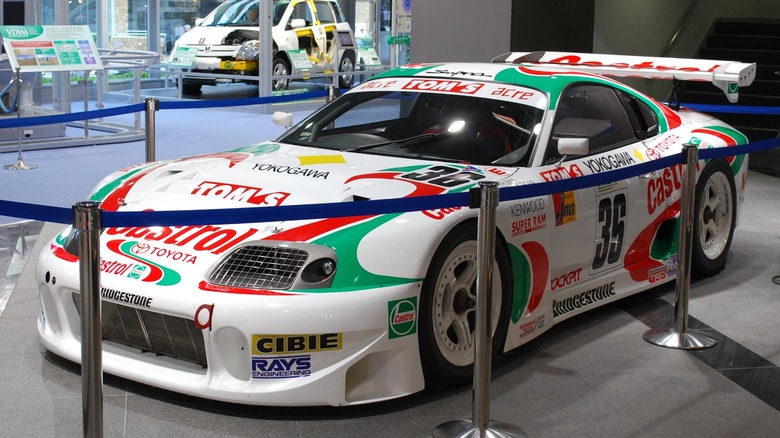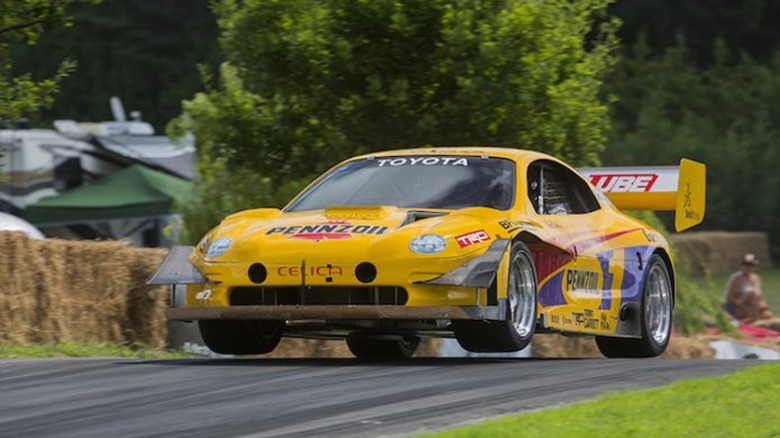Which Cars Have A Toyota 503E Engine Under The Hood?
Toyota's racing history extends back nearly 70 years, starting when the company began competing in rally competitions in 1957. Since then, Toyota has built a motorsport dynasty, with five Le Mans wins, eight World Rally Championship manufacturer titles, 53 IMSA victories, and eleven GT500 team wins under the company's belt. There's a common thread that runs through many of Toyota's most celebrated racing accomplishments, the 503E inline-four-cylinder engine.
Toyota's 503E engine was built out of Toyota's desire for dominance in motorsports of all kinds. In the 1980s, Toyota was taking its motorsport endeavors very seriously, especially Le Mans prototype racing and IMSA. Toyota had a 2.1-liter four-cylinder engine, known as the 4T-GT in the early years of its Le Mans efforts, but it was underpowered and unreliable. So, Toyota introduced a new 2.1-liter turbocharged twin-cam four-cylinder to replace it.
The new engine went by many names. Internally, the new engine was called the 503E; however, it is also commonly called the 3S-GT and 3S-G. The 503E received a big bump in boost and horsepower over the 4T-GT, producing between 500 and 850 horsepower in its many motorsport applications. Over the next decade, the 503E proved to be a dominant race motor, powering some of Toyota's most iconic vehicles to victory in multiple disciplines of motorsport.
Toyota 503E in Le Mans Prototypes
Toyota entered the 24 Hours of Le Mans for the first time in 1985 with the 85C prototype, which was a collaborative effort between the TOMs race team, Dome chassis manufacturer, and Toyota's TRD Racing Division. Integrated into the 85C chassis was a turbocharged 2.1-liter Toyota twin-cam four-cylinder, internally known as the 4T-GT. Unfortunately, the estimated 500 horsepower 4T-GT wasn't powerful enough for the 85C to compete with the best of the field, leading to a 12th-place overall finish in the race. Despite returning in 1986 with a completely redesigned chassis, the 4T-GT was once again the downfall of that year's 86C car, as both factory entries retired due to engine reliability problems.
In 1987, Toyota was determined to put up a more serious fight. As an evolution of the previous model, the 1987 87C was built on a revised 86C chassis. However, under its skin, the 87C received a massive upgrade. Toyota decided to swap out the lethargic 4T-GT with the race-proven 503E 2.1-liter turbocharged inline-four cylinder that had already destroyed the competition in the All-Japan Sports Prototype Car Endurance Championship. In the 87C, the 503E made 680 horsepower, 180 more than the outgoing 4T-GT. The 503E-powered 87C would go on to win both the Fuji 1000 km and Suzuka that year but would fail to finish in the 24 Hours of Le Mans. The 503E was used again for 1988 in the Toyota 88C, which finished the 1988 24 Hours of Le Mans in 12th place amongst stiff competition.
Toyota 503E in IMSA
IMSA, or the International Motor Sports Association, was formed in 1969 as an American sports car series that offered the same level of professional organization as NASCAR. By the 1980s, IMSA was becoming a major player in the realm of international motorsport, attracting entries from around the world. In 1983, the All-American Racers team, led by decorated driver Dan Gurney and known for developing Formula 1 cars in the mid-1960s, teamed up with Toyota to make the IMSA Celica a threat on the racetrack. The effort paid off in 1987 when the AAR-Toyota Celica GTO won the IMSA GTO Constructors' Championship with a 4T-GTE straight-four under its hood.
After AAR-Toyota's win in the GTO category, the logical next step was the more extreme grand touring prototype (or GTP) class. To race in the GTP class in 1989, AAR and Toyota entered a new model developed from the Toyota 88C Le Mans prototype car. The new AAR-Toyota HF89 (also known as the Eagle Mk II) featured a rigid aluminum monocoque chassis and a separate rear subframe that housed the famous 503E inline-four, producing 630 horsepower in IMSA trim. While the 1989 season was used to iron out reliability issues, the HF89 went on to win four races in the 1990 IMSA season, finishing second in the overall standings.
The next version of the AAR-Toyota GTP car, known as the Eagle MkIII, was introduced in late 1991 for the 1992 IMSA season. It solved many of the aerodynamic issues faced by the Eagle Mk II and used a refined version of the 503E, which was boosted to a whopping 750 horsepower. What followed was sheer dominance, with the Eagle Mk III winning 21 or 27 IMSA races between 1991 and 1993.
Toyota 503E in GT cars
The All Japanese Grand Touring Car Championship, known as the JGTC for short, was a GT racing series that took place in Japan between 1993 and 2004 before being renamed to Super GT where it continues to this day. The JGTC included two classes, the lower spec GT2 class and the fire-breathing, 500 horsepower GT1 class.
The Nissan R32 GTR had been dominating in every racing series that it entered, but especially the Japanese Touring Car Championship. The R32 won every single Japanese Touring Car Championship race that it entered (even before the JGTC was created) between 1990 and 1993, totaling 29 wins. That dominance carried into the JGTC, with the Skyline winning the 1993 and 1994 seasons. Toyota responded by entering the two-year-old Mk IV Supra in the JGTC for the 1995 season. While the 2JZ-GTE was a very special engine in the road car, it was too heavy and inefficient for GT racing. So, Toyota swapped the factory 2JZ-GTE with the 503E, which was detuned from its IMSA counterpart to meet the GT1-spec horsepower limit.
The Supra lost to the R32 yet again that year and was embarrassed by the dominant McLaren F1 the year after, but 1997 was a turnaround year for the 503E-powered Supra. The factory-backed TOMs team fought tooth and nail with the SARD team, also racing a 503E Supra, through the season, ultimately tying at the final race at Sugo. Due to favorable results earlier in the season, Toyota Team TOMs took the Supra to its first JGTC GT500 victory in 1997. The greatest Supra in racing history went on to win three more championships, thanks in large part to the 503E.
[Featured image by Mytho88 via Wikimedia Commons | Cropped and scaled | CC BY 3.0]
Toyota 503E in hill climb cars
The Pikes Peak International Hill Climb is one of the most dangerous and rigorous motorsport events in the world. Started in 1916, the PPHC is also the second-oldest automotive race in the United States and has been attracting daredevils and gutsy manufacturers since the very beginning. While there have been some speedy record runs in the hill climb's 100-plus-year history, Rod Millen's 1994 record behind the wheel of a specially built 503E-powered Toyota Celica is one of the all-time greats.
By 1994, racing legend Rod Millen had already competed in IMSA, SCCA PRO Rally, and even the Pikes Peak Hill Climb. However, he wanted his 1994 run to be a legendary one. Millen decided to partner with Toyota for his 1994 attempt for a couple of reasons. He figured that the new Toyota Celica would be a good platform to start with because its all-wheel-drive capabilities would make it good on the dirt track and Toyota also agreed to give him some of Dan Gurney's spare 503E engines from the AAP-Toyota IMSA project that had just concluded. Millen got to work adapting the Celica chassis for the hill climb, which used an underlying tube chassis and carbon fiber body. It featured an aggressive aero package and leveraged ground effect aerodynamics to keep it adhered to the ground. In hill climb-spec, the 503E made a gargantuan 850 horsepower.
In the hillclimb itself, Rod Millen completed the 12.42-mile course in just 10:04.06. Traversing 156 turns with no safety measures in place to prevent a nearly 5,000-foot roll down the mountain, Millen set the new Pikes Peak International Hill Climb record by 40 seconds. The record set in the 503E-powered Celica would stand for 13 years.
